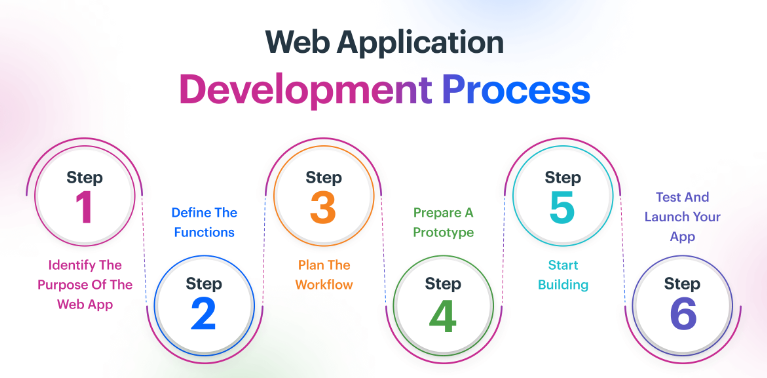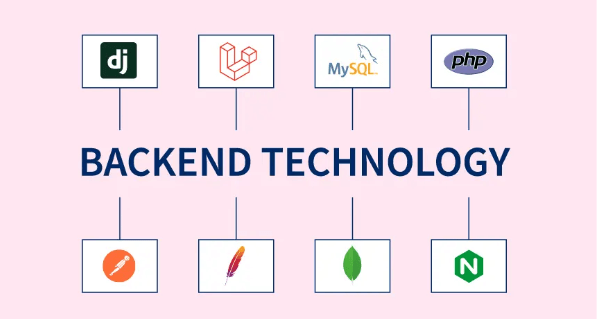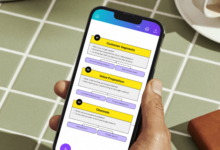Beyond Websites: Exploring the World of Web App Development

Step into the future with us as we unravel the captivating realm of web app development.
In a world where static websites once ruled, the dynamism of web applications is transforming the digital landscape. Web development trends are evolving at breakneck speed, paving the way for an exhilarating future.
Imagine websites that not only showcase information but actively engage users, provide real-time updates, and seamlessly adapt across devices. This is the world of web applications.
From the latest web development technologies to the rise of Progressive Web Apps (PWAs), we embark on a journey that transcends the ordinary. The future of web app development is not just about creating websites; it’s about crafting immersive experiences that captivate and delight._
Join us as we navigate the complexities and opportunities that the world of web applications presents.
This guide to web application development is your compass in this dynamic landscape. Are you ready to explore the unlimited possibilities? Let’s dive in.
Link up with top-notch web development companies to stay ahead in this transformative era. Discover the power of application development services and unleash the potential of your digital presence.
The Distinction: Websites vs. Web Applications

In the ever-evolving world of web app development, understanding the fundamental differences between traditional websites and dynamic web applications is crucial. Let’s unravel this distinction in simple terms.
Websites:
Websites primarily serve as digital brochures, offering static content for visitors. They’re like online pamphlets showcasing information, often one-way communication. Static pages and limited interactivity define the traditional website landscape.
Web Applications:
On the other side, web applications are the architects of user engagement. These dynamic entities offer more than information; they provide functionality, interactivity, and real-time responsiveness. Think of web applications as digital tools, not just pages.
Key Differences:
- Websites are informational; web applications are interactive.
- Websites are static; web applications are dynamic.
- Websites deliver content; web applications deliver experiences.
Recognizing this distinction becomes pivotal as we navigate the future of web app development. The latest web development technologies are steering us toward a landscape where user engagement is not just encouraged but expected.
Why Choose Web Applications?

In the dynamic world of web applications, the choice between traditional websites and their more interactive counterparts is no longer a mere preference; it’s a strategic decision. Let’s explore why opting for web applications is becoming imperative for businesses.
Enhanced User Experience:
Web applications transcend static content, offering users an immersive journey rather than a passive visit. With dynamic interfaces, personalized experiences, and real-time updates, users are engaged in ways that websites can’t replicate.
Interactivity and Real-time Updates:
Imagine a platform that responds to user inputs in real-time. Web applications bring this to life, fostering user engagement through dynamic features, live chats, and instant updates. It’s a two-way street of communication, transforming visitors into participants.
Cross-Platform Accessibility:
Web applications adapt seamlessly across devices, ensuring a consistent and optimized experience whether accessed from a desktop, tablet, or smartphone. This flexibility not only caters to diverse user preferences but also aligns with the evolving digital landscape.
Utilizing Device Features:
Bringing the device’s power into play, web applications leverage features like cameras, geolocation, and push notifications. This adds layers of functionality, making the user experience not just digital but sensory and responsive.
In web development future, the shift towards web applications is a strategic move. The latest web development technologies prioritize not just information delivery but interaction and engagement.
Technologies Powering Web Applications
In the ever-evolving landscape of web applications, the foundation is laid by a sophisticated ensemble of technologies that seamlessly work together to create immersive digital experiences.
Front-end Development Services:

HTML, CSS, JavaScript:
- HTML (HyperText Markup Language) structures the content.
- CSS (Cascading Style Sheets) styles and enhances the layout.
- JavaScript brings interactivity to life, making the web application dynamic.
Frameworks: React, Angular, Vue:
- Frameworks like React, Angular, and Vue provide robust structures for building responsive and feature-rich user interfaces.
- React excels in component-based development, Angular is a comprehensive MVC framework, and Vue offers simplicity and flexibility.
Backend Development:

Server-Side Scripting (Node.js, Django, Flask):
- Node.js enables server-side JavaScript, fostering asynchronous and event-driven applications.
- Django, a Python framework, and Flask, a microframework, streamline backend development with elegance and efficiency.
Databases (MongoDB, MySQL, PostgreSQL):
- MongoDB, a NoSQL database, excels in handling unstructured data.
- MySQL and PostgreSQL, relational databases, ensure structured data management.
APIs and Microservices:
- APIs (Application Programming Interfaces) facilitate seamless communication between different application components.
- Microservices architecture breaks down the application into modular and independent services, enhancing scalability and maintainability.
The synergy of these technologies forms the backbone of web applications, propelling us into the future of web app development.
As the world of web applications evolves, staying abreast of the latest web development technologies becomes pivotal. Engage with a leading web development company to harness the potential of these tools and create web applications that stand at the forefront of innovation.
The Rise of Progressive Web Apps (PWAs)

In the ever-evolving World of Web Applications, a notable entrant has been making waves—Progressive Web Apps (PWAs). This innovative approach to web development seamlessly merges the best of both worlds: the reach of the web and the performance of native applications.
What makes PWAs stand out?
Enhanced User Experience:
PWAs offer a smooth, app-like experience directly through the browser, eliminating the need for installations. This not only simplifies user engagement but also ensures a consistent experience across devices.
Read also PME: Protective Multiple Earthing and Its Importance
Offline Functionality:
Pioneering the way in offline functionality, PWAs allow users to access certain features even when disconnected. This is a game-changer, especially in regions with inconsistent internet connectivity.
Secure and Reliable:
PWAs boast enhanced security protocols, ensuring a secure environment for both users and data. The reliability of these applications contributes to a positive user perception.
Cross-Platform Compatibility:
Catering to the diverse landscape of devices, PWAs work seamlessly across various platforms. This adaptability aligns with the dynamic nature of the digital ecosystem.
Automatic Updates:
PWAs stay current with the latest content and features without requiring manual updates. This automatic evolution ensures users always experience the most optimized version.
PWAs are emerging as a driving force in the future of web app development. As web development trends lean towards user-centric and responsive experiences, PWAs exemplify a paradigm shift in web application design.
Challenges in Web App Development

Embarking on the journey of web app development is undoubtedly exciting, but it comes with its challenges. Navigating these hurdles is key to delivering a seamless and robust digital experience.
Security Concerns:
In the World of Web Applications, security is paramount. With an ever-increasing number of cyber threats, safeguarding user data and application integrity poses a constant challenge. Rigorous security protocols and continuous monitoring are imperative.
Performance Optimization:
As web applications become more feature-rich, optimizing performance becomes a balancing act. Ensuring quick load times and smooth interactions across devices and network conditions is a perpetual challenge.
Compatibility and Cross-Browser Issues:
The diverse landscape of browsers and devices introduces compatibility challenges. Maintaining consistency across different platforms requires thorough testing and adaptability.
User-Centric Design Principles:
Creating web applications that align with user expectations and preferences is an ongoing challenge. Adhering to user-centric design principles and gathering user feedback are essential for continuous improvement.
Agile Development and Collaboration:
In an era where rapid development is crucial, embracing agile methodologies while fostering effective collaboration among development teams can be challenging. Coordination and communication are vital to keep the development process agile.
Integration of New Technologies:
With the future of web app development bringing forth new technologies, integrating them seamlessly into existing web applications poses a challenge. Staying ahead of the latest web development technologies is essential.
Overcoming these challenges requires a strategic approach. Collaborate with a leading web development company to navigate these complexities seamlessly. As we delve into web development trends, addressing challenges becomes a cornerstone for creating exceptional digital experiences.
Future Trends in Web App Development

As we stand at the precipice of the digital frontier, the future of web development promises an exhilarating journey filled with innovation and transformation. Here’s a glimpse into the trends shaping web application landscape.
Integration of AI and MachiTips for Web App Development Successne Learning:
The world of web applications is embracing the capabilities of artificial intelligence and machine learning. From personalized user experiences to intelligent automation, integrating these technologies is set to redefine user interaction.
Augmented Reality (AR) and Virtual Reality (VR):
Immersive technologies like AR and VR are stepping into the forefront of web app development. Envision web applications beyond the screen, providing users with interactive and immersive experiences.
Blockchain and Web 3.0:
The decentralized nature of blockchain technology is influencing the next phase of the internet, commonly known as Web 3.0. This evolution brings forth enhanced security, privacy, and new possibilities for peer-to-peer interactions.
Responsive and Accessible Design:
As future of web app development unfolds, an unwavering focus on responsive and accessible design is evident. Web applications are expected to seamlessly adapt to various devices and ensure inclusivity for all users.
Progressive Web Apps (PWAs) Evolution:
PWAs are not just a trend but an evolution. As they continue to gain prominence, the line between web and native applications blurs further, offering users a faster, more reliable, and engaging experience.
Voice User Interface (VUI):
Voice interactions are becoming increasingly prevalent. Integrating voice user interfaces into web applications enables hands-free interactions, catering to the growing preference for voice-based commands.
Dark Mode and Customization:
Dark mode has become a popular user preference, and customization options are on the rise in application development services. Future web applications will offer users the flexibility to personalize their experiences, enhancing user satisfaction.
Mobile-First Development:
With the increasing reliance on mobile devices, the latest web development technologies are geared towards mobile-first development. Creating applications that prioritize mobile responsiveness ensures broader user reach.
To stay ahead in web applications, collaborating with the top website development services company is imperative. These trends shape the future and present exciting opportunities for businesses to innovate and elevate their digital presence.
Tips for Web App Development Success

Embarking on a web app development journey is an exciting yet intricate process. To ensure success in the ever-evolving world of web applications, consider these essential tips:
User-Centric Design Principles:
Keep the end-users in mind throughout the development process. Prioritize intuitive design, seamless navigation, and a positive user experience.
Continuous Testing and Debugging:
Periodic testing is not a phase; it’s a continuous process. Regularly debug and test your web application to identify and resolve issues promptly.
Collaboration and Agile Development:
Foster effective collaboration among team members. Embrace agile website app development methodologies to ensure flexibility and adaptability.
Adapt to Web Development Trends:
Stay abreast of the latest web development technologies and trends. Flexibility and adaptation to emerging trends are key to staying competitive.
Prioritize Security Measures:
Security is non-negotiable. Ensure that you implement strong security measures in order to protect your users’ data and maintain the integrity of your web application.
Optimize for Performance:
Optimize your web application for speed and performance. Quick load times and smooth interactions contribute to a positive user experience.
Utilize Powerful Web Development Tools:
Leverage powerful tools that enhance development efficiency and streamline processes. The right tools contribute to a more effective and productive workflow.
Responsive Design is Non-Negotiable:
Design your web application with responsiveness in mind. Ensure a seamless experience across various devices, catering to users’ diverse preferences.
Iterate Based on User Feedback:
User feedback is invaluable. Actively seek and incorporate feedback to iteratively improve your web application based on real-world user experiences.
Engage with a Web Development Company:
Partnering with a reputable web development company brings expertise and experience to your project. Their insights can navigate challenges and contribute to the success of your web application.
In the future of web app development, success lies in a holistic approach that balances innovation, user experience, and adaptability. These tips guide navigating the complexities and ensuring your web application stands out in the digital landscape.
Conclusion
In exploring the dynamic world of web applications, we’ve witnessed a transformative journey from static websites to immersive, interactive platforms.
Future of web app development is not just about coding; it’s about crafting digital experiences that captivate and engage users.
As we navigate the latest web development technologies and embrace emerging web development trends, the significance of web applications becomes more evident than ever.
So, what’s next on your digital horizon?
Dive into the possibilities of web app development, where innovation meets user-centric design.
Embrace future of web app development by leveraging powerful tools, staying agile, and prioritizing user experiences.
Ready to turn your vision into a reality? Partner with ValueCoders, a leading web development company to harness expertise and create web applications that stand out in the digital landscape.
Embark on the journey of possibilities. Elevate your digital presence with ValueCoders. Your vision, their expertise. Let’s build the future together.







